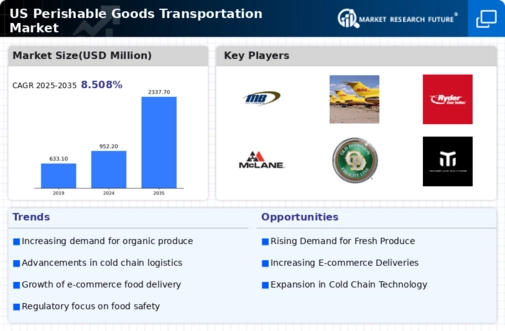The perishable goods transportation market is characterized by a dynamic competitive landscape, driven by the increasing demand for fresh produce and temperature-sensitive products. Key players such as C.H. Robinson (US), XPO Logistics (US), and J.B. Hunt Transport Services (US) are strategically positioned to leverage their extensive networks and technological advancements. C.H. Robinson (US) focuses on digital transformation, enhancing its logistics platform to optimize supply chain efficiency. Meanwhile, XPO Logistics (US) emphasizes sustainability initiatives, aiming to reduce carbon emissions through innovative transportation solutions. J.B. Hunt Transport Services (US) is actively pursuing regional expansion, enhancing its service offerings to meet the growing needs of the market. Collectively, these strategies contribute to a competitive environment that prioritizes efficiency, sustainability, and technological integration.
In terms of business tactics, companies are increasingly localizing their operations to better serve regional markets and optimize supply chains. The market structure appears moderately fragmented, with several key players exerting influence over various segments. This fragmentation allows for a diverse range of services, yet the collective strength of major companies shapes pricing strategies and service standards across the industry.
In November 2025, C.H. Robinson (US) announced a partnership with a leading technology firm to enhance its predictive analytics capabilities. This strategic move is likely to improve demand forecasting and inventory management, enabling the company to respond more effectively to fluctuations in consumer demand. Such advancements may provide C.H. Robinson (US) with a competitive edge in optimizing its logistics operations.
In October 2025, XPO Logistics (US) unveiled a new fleet of electric vehicles designed for perishable goods transportation. This initiative underscores the company's commitment to sustainability and positions it favorably in a market increasingly focused on reducing environmental impact. The introduction of electric vehicles could potentially lower operational costs while appealing to environmentally conscious consumers.
In September 2025, J.B. Hunt Transport Services (US) expanded its refrigerated transport services by acquiring a regional logistics provider. This acquisition is indicative of J.B. Hunt's strategy to enhance its service portfolio and strengthen its market presence. By integrating the capabilities of the acquired company, J.B. Hunt (US) may improve its operational efficiency and expand its reach in the perishable goods sector.
As of December 2025, current trends in the perishable goods transportation market include a pronounced shift towards digitalization, sustainability, and the integration of artificial intelligence (AI) in logistics operations. Strategic alliances among key players are shaping the competitive landscape, fostering innovation and collaboration. The evolution of competition appears to be moving away from price-based strategies towards a focus on technological advancements and supply chain reliability. This shift suggests that companies that prioritize innovation and sustainability will likely differentiate themselves in an increasingly competitive market.






















Leave a Comment